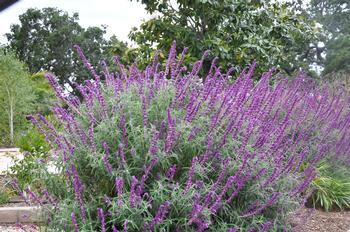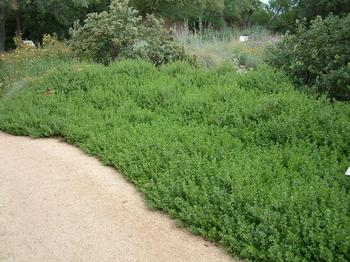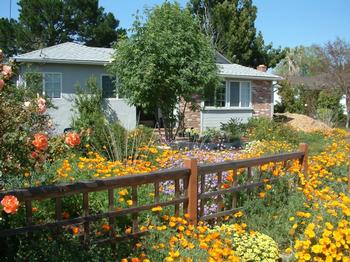Plants that get by on no water once established
-
Diane Lynch
-
With another drought of historic proportions upon us, we must conserve. Fortunately there are many plants that can get by without water after they’re established. Granted, they’ll need water for the first year or two but after that they’ll make it on their own. Fall is the best time to establish new plantings as we cross our fingers for a rainy winter.
Many salvias fall into this category. Salvia leucantha, also known as Mexican sage, is a hummingbird magnet and can be divided every few years, so you get three in one: bird attractant, free plants, no water. What’s not to like? Other salvias include S. clevelandii, S. apiana, and S. leucophylla, all California natives used to dry conditions. Some are upright, others spreading, making them useful groundcover. Salvia leucantha blooms for months and months, requires no supplemental water once established, and is a hummingbird favorite. Photo: PlantMaster
Salvia leucantha blooms for months and months, requires no supplemental water once established, and is a hummingbird favorite. Photo: PlantMasterRhamnus alaternus, Italian buckthorn, a Mediterranean native well adapted to California, comes in both green, which will grow to 10-20’, and variegated, which will reach only 6-8’ and makes a lovely backdrop to a dark background. If you plant the variegated cultivar be sure to remove any green shoots that appear so they don’t take over. I love the interest of variegated foliage and the fact that it’s often slower growing, cutting maintenance.
If you have a big space to fill consider a Ceanothus or California lilac, a bee magnet. With colors from white to intense blues and sized from quite small to 20’ tall and wide, consult your Sunset Western Garden Book or other resource to choose the species best suited to your garden.
We associate succulents with low water use. Some, such as Sedum spathulifolium, native from California to British Columbia, can go dry without losing their good looks. It comes in blue-green and purple cultivars. People often think succulents need full sun but some, such as Aeoniums, appreciate protection from mid-day sun. They thrive in some shade and do appreciate a little water. Use Pigeon Point coyote bush on hillsides or as lawn replacement. No water required on the coast, and monthly in hot-summer areas. Photo: PlantMaster
Use Pigeon Point coyote bush on hillsides or as lawn replacement. No water required on the coast, and monthly in hot-summer areas. Photo: PlantMasterArtemisia ‘Powis Castle’ has beautiful, fluffy, gray-green foliage and will grow to a 6’ mound, making a beautiful backdrop for bright colors. Baccharis pilularis ‘Pigeon Point’ is a native coyote brush that makes a great groundcover for banks and flat areas. Near the coast it needs no water at all; inland a drink once a month will keep it going. It can grow to a small hedge, 3’ high by 9’ wide.
If you aspire to help the monarch butterfly, plant a clump of milkweed. Asclepias fascicularis is one of several milkweeds that nurture the caterpillars (who will not eat other plants) into their next stage as a chrysalis—this lifecycle is stunningly beautiful to witness. If you buy plants from a nursery make sure they’re labeled as having no neonicotinoids used in the growing process—the systemic poison will kill the caterpillars.
Heuchera maxima, island alum root, native to the Channel Islands, flowers in spring and thrives in shade, especially under coast live oaks. Monardella villosa or coyote mint, flowers in summer, attracting butterflies and hummingbirds. Blue-eyed Grass, Sisyrinchium bellum, likes sun, grows about a foot tall, tolerates seaside conditions, and blooms in summer all around Marin. Tidy tips, Layia platyglossa, are the bright yellow essence of spring in California, and the birds love the seeds. No list of native plants should be without Eschscholzia californica, our beautiful, happy state flower. I’ve found that poppies are not always easy to get started, but I keep trying to grow these great pollinators. Birds like the seeds so try hiding them around other plants. Many California native plants, including poppies, require little or no water once established. Photo: PlantMaster
Many California native plants, including poppies, require little or no water once established. Photo: PlantMasterLast but not least, Toyon, Heteromeles arbutifolia, is a fantastic habitat plant. Often a handsome shrub that grows to about 8’, it can grow into a small tree. Mine has grown to almost 20’ and attracts many species of birds, who come for the bugs and red berries that ripen in winter. Common names include Christmas berry and California holly, which sparked the name of Hollywood.



